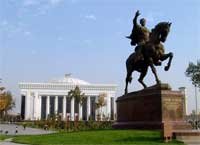Industrial output of Uzbekistan hits 91.7 trln. soums in 2015. 1
ADB: Uzbekistan’s economy to grow by 6.9% in 2016. 1
Strategy of Effective Partnership. 1
PRESIDENCY OF UZBEKISTAN IN THE SHANGHAI COOPERATION ORGANIZATION (2015-2016) 2
Meeting of experts of working group. 2
Published “Architectural Atlas of Bukhara”. 2
economy
Industrial output of Uzbekistan hits 91.7 trln. soums in 2015
Uzbekistan produced industrial products for 91.705 trillion soums (currency rates of CB RU from 01.04.2016, 1$= 2876.72 soums) in January-December 2015, which rose by 8% compared to 2014, the State Statistics Committee of Uzbekistan said. The labor productivity increased by 6.3%.
The share of small business in industrial production rose from 34.8% in 2014 o 38.9% in 2015, the committee said.
Within the Programme on localization of manufacturing of finished products, components and materials, the enterprises manufactured products to the amount of 4.007 trillion soums.
Uzbek enterprises produced consumer goods for 36.193 trillion soums, which rose by 9.7% compared to 2014. The volume of produced food goods made up 16.652 trillion soums (+17.8%) and non-food goods – 19.631 trillion soums (+3.6%)
The share of consumer goods in the total volume of industrial production has reached 39.5%.
(Source: UzDaily.com)
ADB: Uzbekistan’s economy to grow by 6.9% in 2016
The growth of economy of Uzbekistan will make up 6.9% in 2016 due to unfavorable situations in external markets, the Asian Development Outlook of the Asian Development Bank (ADB) said.
Earlier in September 2015, the ADB forecasted that the growth of the GDP of Uzbekistan in 2016 will be 7%. The Government of Uzbekistan forecasts that the economy of Uzbekistan will grow by 7.8%.
According to the forecasts of the ADB’s experts, economy of Uzbekistan will make up 7.3% in 2017. In September 2015, the bank forecasted that the growth of Uzbekistan’s GDP will make up 7.2% in 2017.
The report said that economic situation in the countries, which are main trade partners of Uzbekistan and decrease of prices to main export commodities, will negatively impact to growth of Uzbekistan’s GDP.
Asian Development Outlook and Asian Development Outlook Update are ADB’s flagship economic reports analyzing economic conditions and prospects in Asia and the Pacific, and are issued in April and October, respectively.
(Source: UzDaily.com)
investments
Strategy of Effective Partnership
A renowned Bangladeshi pharmaceutical company, Biopharma Laboratories, intends to launch a manufacture of a wide range of vitamins, antibiotics and substances in Tashkent.
The new facility will be established on the basis of Albi-Pharma joint venture. At the first stage, it is planned to commission the production capacities of 30 million conventional units per year. Investments will make up nearly $1 million.
The Bangladeshi investors completed the construction and installation works at the buildings of the new plant by almost 90%, and built the transport and economic infrastructure. Contracts for the supply of technological equipment for the production of drugs were signed with several foreign companies. It will be delivered to Uzbekistan by the end of the current year, and completion of the commissioning works is scheduled for the first quarter of 2017.
According to Extraordinary and Plenipotentiary Ambassador of Bangladesh Mosud Mannan, the company promises to be the first sign of cooperation between the two countries in the field of pharmaceutics. About a dozen of new companies with the Bangladeshi capital will appear in Uzbekistan in the next few years to specialize in the production of various medicines.
According to the Ambassador, Uzbekistan is interesting for the Bangladeshi businessmen not only in terms of benefits, but to a greater extent in terms of the potentially great opportunities for easy access to the CIS markets. This suggests the emergence of new companies in other industries, especially in the light industry.
Drug sales made up $1.3 billion in Uzbekistan last year, with imported drugs accounting for about $900 million.
(Source: «Uzbekistan Today» newspaper)
PRESIDENCY OF UZBEKISTAN IN THE SHANGHAI COOPERATION ORGANIZATION (2015-2016)
Meeting of experts of working group
On March 30, 2016, Dushanbe held the meeting of experts of working group of the SCO Member States on law enforcement and suppression of drug-related crimes.
Representatives of China, Kazakhstan, Kyrgyzstan, Russia, Tajikistan and Uzbekistan discussed topical issues of cooperation in combating illicit trafficking of drugs, psychotropic substances and their precursors, as well as the joint activities.
The sides exchanged views on the drafts of Anti-Drug Strategy for 2017-2022 and Action Programs on its implementation as well as the other issues.
(Source: Press Service of the MFA of the Republic of Uzbekistan)
Tourism
Published “Architectural Atlas of Bukhara”
KNAUF Uzbekistan presented new “Architectural Atlas of Bukhara” on 30 March 2016. It was prepared by a famous Uzbekistan archaeologist Candidate of Archaeologic Sciences Elizaveta Nekrasova.
The guide was issued at the KNAUF’s initiative. The “Architectural Atlas of Bukhara” was composed by Elizaveta Nekrasova, archaeological scientist of Tashkent Renovation Institute, who had dedicated all her life to historical and archaeological research of Uzbekistan and Bukhara in particular.
The publication was intended for a high readership from tourists to Architecture professionals. The Atlas was called to tell people about the historical importance of Bukhara and the stages of its city-planning destiny as well as to highlight once again the greatness and richness of the old city.
The guide is a unique publication which materialized the result of painstaking work of cartographers, artists and talented photographers. They had managed not only to ingeniously describe and chase the great city in all its glory, but also to compose the Atlas in an available format from a tourist’s point of view.
The atlas presents about twenty historic buildings which appeared during the period from the beginning of the XIV till the end of XX century. The water facilities system of Bukhara with its numerous houzs alone deserves enthusiastic epithets to talented architects of that time. The edition also tells us, how much attention has been paid to each building till the present day, what a titanic work has been made in the sake of saving the primeval beauty of masterpieces created by great architects of the past.
“Bukhara is an incredible architectural furiousness of styles, an amazing combination of pomposity and asceticism, a mixture of the most various buildings. And the KNAUF support in publishing this guide is one more little contribution of our company into consolidation of friendship and cooperation with Uzbekistan”, the company’s co-owner Nicolas Knauf said in his greeting to the architectural atlas.
“Due to its geographic location, Bukhara became a part of the Great Silk Road, and therefore the centre of origin and development of trade relations and experience exchange in various directions. Today there are modern building objects, which become an integral part of city life. Their construction was fulfilled in cooperation with KNAUF, which suggests a new view for building and contributes to the construction industry of the country”, a famous Bukhara architect Zoirsho Klychev said.
The KNAUF Uzbekistan had acted as an exclusive sponsor for the atlas, as it considers such activity to be important to save and develop the perception of architecture as a kind of art.
Manfred Grundke highlighted, “it was a natural decision for the company to maintain such a project, taking into account the importance of the architectural ensemble of Bukhara for the world cultural heritage”.
(Source: UzDaily.uz)
Reference to the source is a must in reproducing materials





















